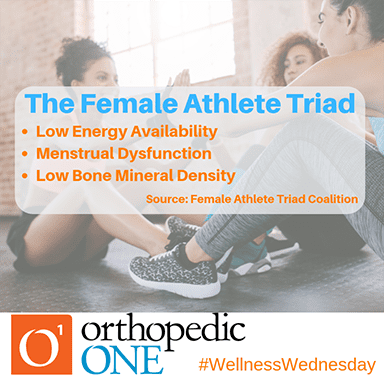The Female Athlete Triad
Like so many other things in life, one aspect of our health can oftentimes influence another. The Female Athlete Triad refers to three health problems that are linked to one another: energy deficiency, menstrual disturbances and bone loss or osteoporosis. If an athlete’s body is lacking in one aspect of the Triad, then she is at a much higher risk of experiencing conditions related to the other two. Oftentimes, female athletes are already experiencing these deficiencies without even knowing it.
While athletes who participate in sports that place an emphasis on leanness or low body weight are particularly at risk for developing the Triad, any athlete can be affected. If gone diagnosed and untreated, the conditions that compose the Female Athlete Triad can cause serious and sometimes lifelong or life-threatening health consequences.

Low Energy Availability (EA)
- Defined as the amount of energy consumed minus the amount of energy expended.
- Low EA effects reproductive and bone health.
- Most common in sports that require high energy demand and lean physiques/aesthetic components (i.e. gymnastics, cross country, and swimming).
- Increased energy intake can partially reverse the effects of low EA.
Menstrual Dysfunction
- Infrequent menstrual cycles.
- Primary amenorrhea: female that has not reached menarche by the age of 15.
- Secondary amenorrhea: Lack of menses exceeding 3 months.
- Menstrual dysfunction leads to decreased levels of estrogen which causes decreased bone density.
Low Bone Mineral Density (BMD)
- Adolescence is the critical time to develop Peak Bone Mass (PBM).
- Decreased bone density leads to stress fractures and fractures and can therefore limit athletic participation.
- Decreased bone density leads to osteoporosis and fractures.
- Osteoporosis is the leading cause of morbidity and mortality in the elderly population.
Treatment
- All active female athletes should be assessed for components of the Triad.
- Multifaceted treatment approach involving the patient, coaches, parents, OB/GYN, sports nutritionist, and mental healthcare provider is optimal.
- The main intervention is adjusting energy imbalances and breaking the cycle.
Source: Female Athlete Triad Coalition